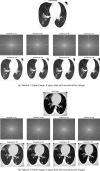An optimized EBRSA-Bi LSTM model for highly undersampled rapid CT image reconstruction
- PMID: 36776947
- PMCID: PMC9904992
- DOI: 10.1016/j.bspc.2023.104637
An optimized EBRSA-Bi LSTM model for highly undersampled rapid CT image reconstruction
Abstract
COVID-19 has spread all over the world, causing serious panic around the globe. Chest computed tomography (CT) images are integral in confirming COVID positive patients. Several investigations were conducted to improve or maintain the image reconstruction quality for the sample image reconstruction. Deep learning (DL) methods have recently been proposed to achieve fast reconstruction, but many have focused on a single domain, such as the image domain of k-space. In this research, the highly under-sampled enhanced battle royale self-attention based bi-directional long short-term (EBRSA-bi LSTM) CT image reconstruction model is proposed to reconstruct the image from the under-sampled data. The research is adapted with two phases, namely, pre-processing and reconstruction. The extended cascaded filter (ECF) is proposed for image pre-processing and tends to suppress the noise and enhance the reconstruction accuracy. In the reconstruction model, the battle royale optimization (BrO) is intended to diminish the loss function of the reconstruction network model and weight updation. The proposed model is tested with two datasets, COVID-CT- and SARS-CoV-2 CT. The reconstruction accuracy of the proposed model with two datasets is 93.5 % and 97.7 %, respectively. Also, the image quality assessment parameters such as Peak-Signal to Noise Ratio (PSNR), Root Mean Square Error (RMSE) and Structural Similarity Index metric (SSIM) are evaluated, and it yields an outcome of (45 and 46 dB), (0.0026 and 0.0022) and (0.992, 0.996) with two datasets.
Keywords: Computed tomography (CT); Deep learning; Image reconstruction; K-space data; Under-sampling.
© 2023 Elsevier Ltd. All rights reserved.
Conflict of interest statement
The authors declare that they have no known competing financial interests or personal relationships that could have appeared to influence the work reported in this paper.
Figures
















Similar articles
-
A geometry-guided multi-beamlet deep learning technique for CT reconstruction.Biomed Phys Eng Express. 2022 May 13;8(4):10.1088/2057-1976/ac6d12. doi: 10.1088/2057-1976/ac6d12. Biomed Phys Eng Express. 2022. PMID: 35512654 Free PMC article.
-
A novel hybrid generative adversarial network for CT and MRI super-resolution reconstruction.Phys Med Biol. 2023 Jun 23;68(13). doi: 10.1088/1361-6560/acdc7e. Phys Med Biol. 2023. PMID: 37285848
-
A geometry-guided deep learning technique for CBCT reconstruction.Phys Med Biol. 2021 Jul 30;66(15):10.1088/1361-6560/ac145b. doi: 10.1088/1361-6560/ac145b. Phys Med Biol. 2021. PMID: 34261057 Free PMC article.
-
Image reconstruction using UNET-transformer network for fast and low-dose PET scans.Comput Med Imaging Graph. 2023 Dec;110:102315. doi: 10.1016/j.compmedimag.2023.102315. Epub 2023 Nov 23. Comput Med Imaging Graph. 2023. PMID: 38006648
-
CT artifact correction for sparse and truncated projection data using generative adversarial networks.Med Phys. 2021 Feb;48(2):615-626. doi: 10.1002/mp.14504. Epub 2020 Dec 30. Med Phys. 2021. PMID: 32996149 Review.
Cited by
-
Using the TSA-LSTM two-stage model to predict cancer incidence and mortality.PLoS One. 2025 Feb 20;20(2):e0317148. doi: 10.1371/journal.pone.0317148. eCollection 2025. PLoS One. 2025. PMID: 39977395 Free PMC article.
References
-
- Alazab M., Awajan A., Mesleh A., Abraham A., Jatana V., Alhyari S. COVID-19 prediction and detection using deep learning. Int. J. Comput. Inf. Syst. Ind. Managem. Appl. 2020;12:168–181.
-
- Waller J.V., Allen I.E., Lin K.K., Diaz M.J., Henry T.S., Hope M.D. The limited sensitivity of chest computed tomography relative to reverse transcription polymerase chain reaction for severe acute respiratory syndrome coronavirus-2 infection: a systematic review on COVID-19 diagnostics. Invest. Radiol. 2020;55(12):754–761. - PMC - PubMed
-
- Mossa-Basha M., Medverd J., Linnau K.F., Lynch J.B., Wener M.H., Kicska G., Staiger T., Sahani D.V. Policies and guidelines for COVID-19 preparedness: experiences from the University of Washington. Radiology. 2020;296(2):E26–E31. - PubMed
LinkOut - more resources
Full Text Sources
Miscellaneous
